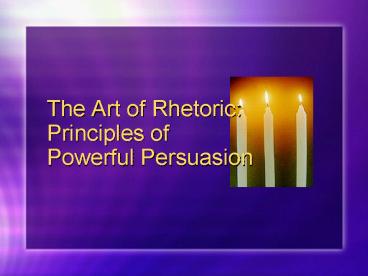The Art of Rhetoric: Principles of Powerful Persuasion PowerPoint PPT Presentation
1 / 25
Title: The Art of Rhetoric: Principles of Powerful Persuasion
1
The Art of RhetoricPrinciples of Powerful
Persuasion
2
What is Persuasion?
- The art of persuasion is the art of finding the
best available means of moving a specific
audience in a specific situation to a specific
decision
3
Rhetorical Situation
- Writer
- Purpose
- Audience
- Topic
- Context
4
WHAT ARE ARGUMENTS?
Arguments are reasons and evidence that show why
listeners should change their minds or take
action on an issue.
The earth is the mother of all people, and all
people should have equal rights upon it. You
might as well expect rivers to run backward as
that any man who was born a free man should be
contented penned up and denied liberty to go
where he pleases. from a speech given by Chief
Joseph in 1879
5
Look for these common types of arguments.
6
(No Transcript)
7
LOOK FOR RHETORICAL DEVICES.
Rhetorical devices are certain ways of looking at
language to persuade readers to listen or to get
their attention.
Words do not pay for my dead people. They do not
pay for my country now overrun by white men. They
do not protect my fathers grave. They do not pay
for my horses and cattle. Good words do not give
me back my children. from a speech given by Chief
Joseph in 1879
8
In most speeches, the speaker is trying to
persuade listeners to
- believe an idea
- support a cause
- take an action
9
Good arguments are coherent.
They
- are logically organized
- show a clear connection between ideas
10
DEDUCTIVE VS. INDUCTIVE REASONING
Deductive pattern moves from general ideas to
more specific ones
Inductive pattern moves from specific ideas to
more general ones
thesis
arguments and reasons
arguments and reasons
thesis
11
The Persuasion Triangle
Presenter (Ethos)
Audience (Pathos)
Subject (Logos)
12
The Three Means of PersuasionDefined
- Logos the logical appeal, an appeal to the
audience's reason based on such techniques as
examples, inductive and deductive reasoning,
definition of terms, critique of the opponent's
logic, etc. - Ethos the ethical appeal, an appeal based on
the character, persona, and/or position of the
speaker. - Pathos the emotional appeal, based on evoking
particular emotions such as fear, envy,
patriotism, lust, etc.
13
Persuasion in the Real World
Audience
Presenter
Your Needs Interests
Their Needs Interests
Subject
14
Persuading is like making a candle
- Melt
- Mold
- Harden Ignite!
Adapted from E.M. Griffin. The Mind Changers.
Wheaton, Illinois Tyndale Publishers, 1976.
15
3 Kinds of Arguments
- Forensic arguments designed to uncover what has
happened in the past, establish actions as just
or unjust, accusation defense - Epideictic concerned with establishing the
noble or shameful in human behavior action
ceremonial praises/blames. - Deliberative a call to action concerned with
making changes in human action/attitude
16
Melting ResistanceWhat an author/speaker must do
with theaudience
- To Raise Resistance
- Be insincere
- Shout Youre wrong!
- Use weak humor
- Guilt trip them
- Use improbable threats
- Lecture them
- To Melt Resistance
- Be honest
- Find common ground
- Use humor carefully
- Appreciate what they are already doing
- Give realistic pros and cons
- Ask them to make your case
17
Molding Opinion Know what moves the Audience
- What do they all commonly want?
18
Molding Opinion
- To trust a speaker, the audience must believe
he/she is a competent person - Ethos relates to this.
19
Molding OpinionGood Rhetors
- Never talk down to or over the heads of the
audience - Try to find common ground
- May use fallacies to enhance power of persuasion
20
In Closing, IGNITE!
- An effective speaker/writer or an argument will
try to BRIDGE any differences, or smooth over any
areas where the audience may disagree or be
offended.
21
Principles for Powerful Persuasion
- Melt Resistance
- Mold Opinions
- Know audience well
- Make argument clear
- Present in a positive manner
- Harden Ignite!
- Believe in the cause
- Summarize make a specific request
22
(No Transcript)
23
(No Transcript)
24
(No Transcript)
25
Questions?

